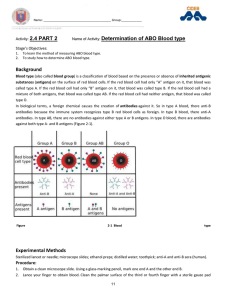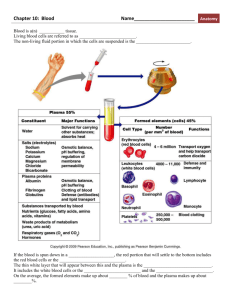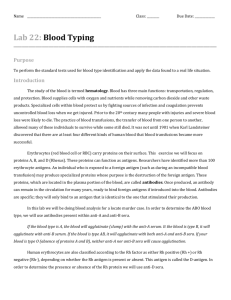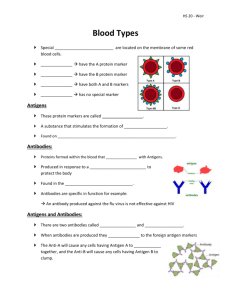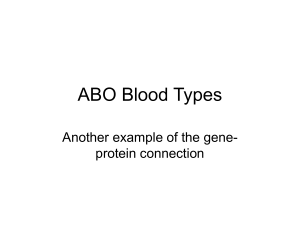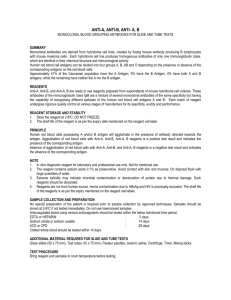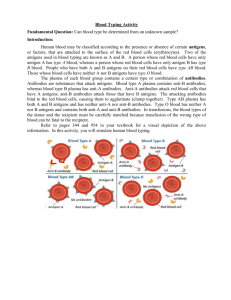Blood Typing Lab - Juniata College
advertisement
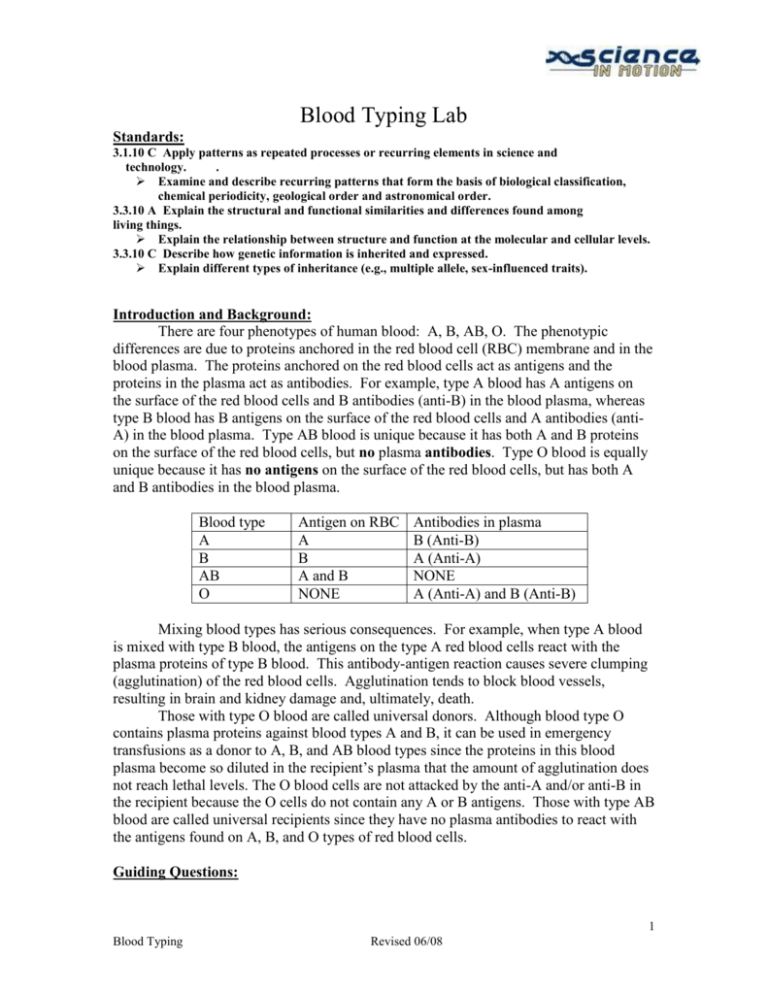
Blood Typing Lab Standards: 3.1.10 C Apply patterns as repeated processes or recurring elements in science and technology. . Examine and describe recurring patterns that form the basis of biological classification, chemical periodicity, geological order and astronomical order. 3.3.10 A Explain the structural and functional similarities and differences found among living things. Explain the relationship between structure and function at the molecular and cellular levels. 3.3.10 C Describe how genetic information is inherited and expressed. Explain different types of inheritance (e.g., multiple allele, sex-influenced traits). Introduction and Background: There are four phenotypes of human blood: A, B, AB, O. The phenotypic differences are due to proteins anchored in the red blood cell (RBC) membrane and in the blood plasma. The proteins anchored on the red blood cells act as antigens and the proteins in the plasma act as antibodies. For example, type A blood has A antigens on the surface of the red blood cells and B antibodies (anti-B) in the blood plasma, whereas type B blood has B antigens on the surface of the red blood cells and A antibodies (antiA) in the blood plasma. Type AB blood is unique because it has both A and B proteins on the surface of the red blood cells, but no plasma antibodies. Type O blood is equally unique because it has no antigens on the surface of the red blood cells, but has both A and B antibodies in the blood plasma. Blood type A B AB O Antigen on RBC A B A and B NONE Antibodies in plasma B (Anti-B) A (Anti-A) NONE A (Anti-A) and B (Anti-B) Mixing blood types has serious consequences. For example, when type A blood is mixed with type B blood, the antigens on the type A red blood cells react with the plasma proteins of type B blood. This antibody-antigen reaction causes severe clumping (agglutination) of the red blood cells. Agglutination tends to block blood vessels, resulting in brain and kidney damage and, ultimately, death. Those with type O blood are called universal donors. Although blood type O contains plasma proteins against blood types A and B, it can be used in emergency transfusions as a donor to A, B, and AB blood types since the proteins in this blood plasma become so diluted in the recipient’s plasma that the amount of agglutination does not reach lethal levels. The O blood cells are not attacked by the anti-A and/or anti-B in the recipient because the O cells do not contain any A or B antigens. Those with type AB blood are called universal recipients since they have no plasma antibodies to react with the antigens found on A, B, and O types of red blood cells. Guiding Questions: 1 Blood Typing Revised 06/08 Science in Motion Juniata College Vocabulary: Antigen (Ag)- An antigen is a foreign substance that induces antibody formation, creating an immune response Antibody (Ab)- An antibody is a protein produced by lymphocytes in response to a specific antigen. When an antigen is present, antibodies act as receptors for the antigen forming an antibody-antigen complex. Such a complex forms the basis of an immune response. Plasma- Plasma is the “liquid portion of the blood containing water, proteins (including fibrinogen), salts, and nutrients” (Brum, G-19). Materials: 1 petri dish with lid sharpie 1 vial anti-A 1 vial anti-B 2 vials unknown sample stir sticks (toothpicks) disposable pipettes with bulb Safety notes: Human blood is not used for this lab, therefore, no special safety precautions are necessary. Procedure: 1. Mark the underside of one half of the petri dish “anti-A” and mark the other part “anti-B”. 2. Add 1 drop of the unknown sample onto side 1 and 1 drop onto side 2. Dispose of the pipet. 3. Add 1 drop of anti-A onto side 1 and use toothpick to mix with sample. Dispose of the toothpick. 4. Add 1 drop of anti-B onto side 2 and use toothpick to mix with sample. Dispose of the toothpick. 5. Check each side for agglutination and record below for positive (agglutination) or negative (no agglutination) reactions. Determine the blood type of your unknown sample. Data: Unknown # Anti –A in side 1 Anti –B in side 2 Blood type of unknown # _____ is ______. reaction (+ or -) ______ ______ 2 Blood Typing Revised 06/08 Science in Motion Juniata College Unknown # Anti –A in side 1 Anti –B in side 2 Blood type of unknown # _____ is ______. reaction (+ or -) ______ ______ Analysis/Conclusion: 1. Record your results on the board. When all of the results are in, calculate the % of each blood type sampled. A blood = % B blood = % AB blood = % O blood = % 2. Make a graph of the class results. 3. What type of blood could your patients safely get a transfusion from? What type of blood transfusion would kill your patients? Why? References: Brum, G., McKane, L., & Karp, G., Biology Fundamentals. John Wiley & Sons, Inc: 1995. 3 Blood Typing Revised 06/08
